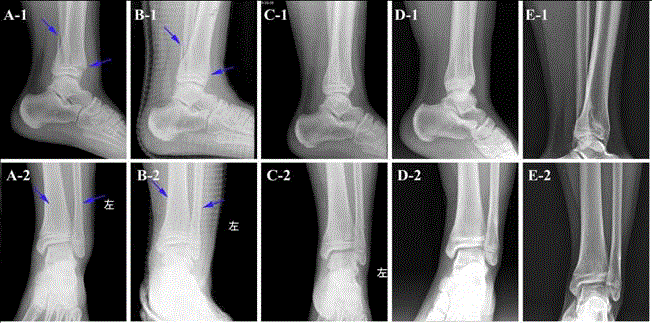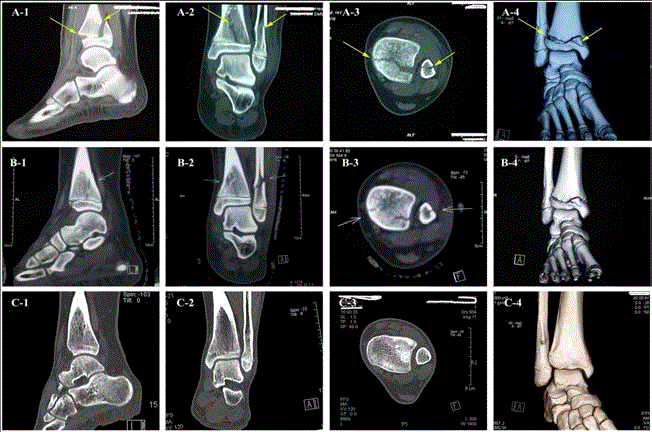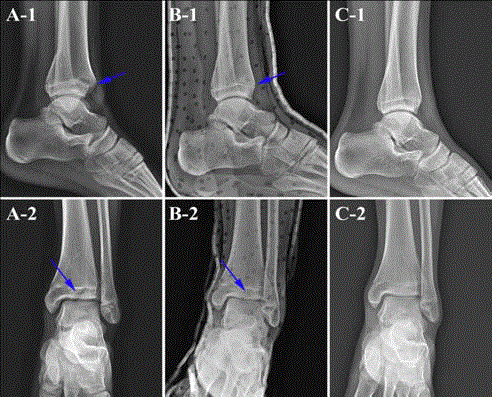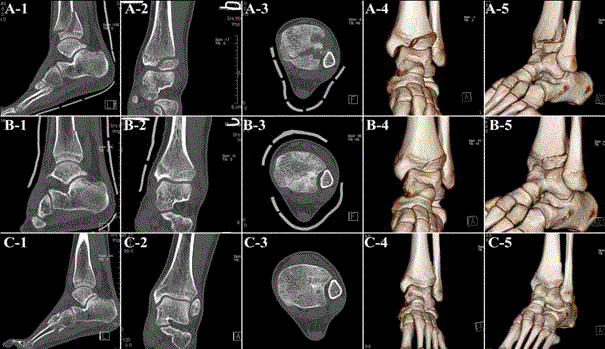Research Article
Closed Reduction Treatment and Outcome of Triplane Fracture of the Distal Tibia: Retrospective Study of 46 Cases
Chi Zhang1, Chongbo Huang1, Jinsong Hong1, Yunfeng Li1, Jianwei Hu1, Weizhong Yu1, Hua Wang2* and Chongxia Huang1*
1Department of Orthopaedic Surgery, Guangzhou Orthopedic Hospital, Guangzhou, P.R. China
2Department of Orthopaedics, First Affiliated Hospital of Sun Yat-sen University, Guangzhou, P.R. China
*Corresponding author: Chongxia Huang, Department of
Orthopaedic Surgery, Guangzhou
Orthopedic Hopital, No.449 of Dongfeng
Middle Road, Guangzhou, P.R. China
Hua Wang, Department Orthopaedics,
First Affiliated Hospital of Sun Yat-sen
University, 58 Zhongshan Second
Road, Guangzhou, P.R. China
Published: 28 Aug, 2018
Cite this article as: Zhang C, Huang C, Hong J, Li Y,
Hu J, Yu W, et al. Closed Reduction
Treatment and Outcome of Triplane
Fracture of the Distal Tibia:
Retrospective Study of 46 Cases. Clin
Surg. 2018; 3: 2088.
Abstract
Objectives: We designed a prospective study to confirm the hypothesis that acute triplane fracture
of distal tibia can be treated conservatively with good range of motion and daily mobility without
pain.
Methods: Forty-six patients participated and completed the study, including 35 male and 11 female.
Inclusion criteria was, patients with acute triplane fractures (≤ 3 days) who received closed reduction
and cast immobilization. Clinical investigation and the foot and ankle outcome score (FAOS) survey
were done. X-rays and computed tomography scan of the ankles were obtained at follow-up.
Results: Fractures were 2-parts in 33 and 3-parts in 13 patients, fracture displacement were <2 mm
in 21 patients and ≥ 2 mm in 25 patients, and 18 patients had concomitant fibular fractures. All
patients were treated conservatively (cast immobilization with closed reduction). The mean period
of cast was 4.3 ± 0.6 weeks; non-weight-bearing in a boot for 3 days, and follow-up period was 63.0 ±
5.4 months. All patients had good outcome, no one has ankle osteoarthritis on X-rays and CT scans
at final follow-up. Mean FAOS score was 97.89 ± 6.15, with FAOS pain 38.70 ± 4.00, FAOS function
49.20 ± 2.29, alignment 10.00 ± 0.00. Patients had full range of motion, good daily mobility and no
pain during walking.
Conclusion: Results confirm the benefit of conservative treatment in acute triplane fracture of distal
tibia that conservative treatment was sufficient to reestablish ankle stability, allowing complete
recovery of ankle Range of motion (ROM) and reducing the risk of early degenerative joint disease,
and it is also cost-effective.
Keywords: Triplane fracture; Ankle; Closed reduction; Outcome
Abbreviations
FAOS: Foot and Ankle Outcome Score; ROM: Range of Motion
Introduction
Distal tibial epiphysis is the second most common site of epiphyseal fracture in the pediatric population, only second to the distal radius [1]. Triplane ankle fractures represents 6% to 10% of distal epihpyseal fracture [2], and typically occur in children aged 12 to 15 years, with more commonly in boys than girls [3]. Primary mechanism of triplane fracture is supination and external rotation of the foot, with plantar flexion [4]. Although many patients sustain triplane fracture during athletic activity, it has also been reported as a consequence of fall or twisting injury while walking [5]. Clinically, swelling and local tenderness over the injured joints are common presentations, and deformity is variable. AP, lateral, and mortise radiographs are essential for initial diagnosis of transitional fracture. Cast immobilization is usually used for minimally displaced (<2 mm) and non-displaced fractures, while closed or open reduction for fractures with >2 mm intraarticular step-off [6]. In recent years, authors advocated reduction with operative stabilization to get adequate reduction and prevent ankle osteoarthritis. However, if closed reduction is successful, open reduction is not required [7]. So, we designed a retrospective project to test the hypothesis that acute triplane fracture of the distal tibia can be treated conservatively with good Range of Motion (ROM) and daily mobility without pain.
Table 1
Figure 1
Figure 1
Case-1 AP (A-1) and lateral (A-2) radiographs of the left ankle demonstrating triplane fracture. (B-1/2) Frontal and lateral radiographs of the left ankle after close reduction and cast immobilization. (C-1/2) One month after treatment, frontal and lateral radiographs showed that fracture line nearly disappeared. (D-
1/2) One year after treatment, the fracture line disappeared. (E-1/2) Four years after treatment, epiphyseal plate closure and no sign of traumatic ankle arthritis.
Figure 2
Figure 2
Case-1 Computed tomographic scans of the left ankle demonstrating in better detail morphologic complexity of the triplane fracture. Sagittal reformation (A-1) demonstrates both physeal (arrow) and posterior metaphyseal (arrow) fracture extension of Salter-Harris type II fracture, in addition to a cortical fracture
fragment interposed along the posterior metaphyseal cortical fracture fragments. Cornoal reformation (A-2) demonstrates the distal fibular shaft is noted. Axial
image at the level of the distal tibial epiphysis (A-3) show epiphyseal widening and displacement in the sagittal plane (arrow). Three-dimensionally shaded surface
reformation (A-4) show antero-medial displacement of the epiphysis and physeal fracture extension of a Salter-Harris type III fracture of the tibia (arrow), in addition
to a distal fibular oblique fracture. (B1-B4) CT scans after close reduction and cast immobilization, fracture displacement was <2 mm. (C1-C4) One year after
treatment, the fracture line disappeared, bone healing was satisfactory.
Materials and Methods
From Sep 2010 to March 2015, records of 34 boys and 12 girls
with triplane fractures were retrospectively reviewed. Inclusion
criteria was, patients with acute triplane fractures (≤ 3 days), who
received closed reduction and cast immobilization. An exclusion
criterion was patients with history of ankle fracture. Approval of the
study was granted by ethics committee of Guangzhou Orthopedic
Hospital. Informed consent was obtained from either the patient or a
family member. Patients' age, gender, mechanism of injury, diagnosis,
displacement and number of fragments, management, and duration of
cast, treatment outcome, and complications (pain, restricted range of
motion or functional deficits) were recorded. Standard AP and lateral
radiographs were taken. CT scans were used to determine the number
and position of fragments [8]. Forty-six patients with acute triplane
fractures received closed reduction and cast immobilization at the
emergency department. An assistant stabilized the knee at 90° during
this forceful manipulation. Lateral fracture segments was pushed
onto the tibia before traction, then the fractures and/or dislocations
were reduced by applying longitudinal traction to the involved
digits with pressure over base of the tibia, which last for three to five
minutes, then pushed the lateral fracture segments again to make its
reduction. Foot positioned in external rotation for medial fractures,
and internal rotation for lateral fractures. Reduction procedure was
performed under C-arm fluoroscopy. After reduction, non-weightbearing
thermoplastic orthoses immobilizations were used initially to
help control secondary dislocation. Thermoplastic orthoses placing
the foot in internal rotation may help reduce the displaced fracture
and maintain alignment [6]. X-rays were taken immediately after
application of the thermoplastic orthoses to confirm reduction. To
assure anatomical alignment and secondary dislocation, frequent
control radiographs were taken. Thermoplastic orthoses were
replaced when swelling of the ankle decreased, generally 5-7 days
after reduction. The injured ankle was immobilized for 4.28 ± 0.58
weeks, after that the thermoplastic orthoses were removed, and X-ray
was taken. Followed by non-weight-bearing in a boot for 3 days and
commencement of range-of-motion exercises, then weight bearing in
the boot for next 2 weeks [9].
Radiographs and medical records of the patients were collected
(Table 1). Fracture healing, presence of deformity, premature closure
of the growth plate, and post-traumatic arthritis were assessed on
radiographs. Treatment outcome (pain, activity, function of ankle
joint, walking ability and radiographs) was evaluated using the Foot
and Ankle Outcome Score (FAOS) by a clinical investigator [10] at
one year post-treatment and final follow-up.
Statistical analysis
Descriptive statistics were evaluated on all baseline variables.
Results are presented as the mean ± SD. Differences between groups
were assessed by analysis of variance. P values less than 0.05 was
considered statistically significant.
Figure 3
Figure 3
Case-2 AP (A-1) and lateral (A-2) radiographs of the left ankle demonstrating a triplane fracture. (B-1/2) Frontal and lateral radiographs of the left ankle after close reduction and cast immobilization. (C-1/2) Three month after treatment, frontal and lateral radiographs showed nearly disappeared fracture line.
Figure 4
Figure 4
Case-2 Computed tomographic scans of the left ankle demonstrating better morphologic complexity of the triplane fracture. Sagittal reformation (A-
5) demonstrates triplane fracture, temporary cast fixation was used to relieve pain. (B1-B5) CT scans after close reduction and cast immobilization, fracture
displacement was <2 mm. (C1-C5) Three months after treatment, the fracture line disappeared, bone healing was satisfactory.
Results
Forty-six patients aged 10-16 years (12.7 ± 1.6) with triplane fractures of the left (n=22) and right (n=24) ankles were treated in our hospital, with follow-up until 54.0 ± 13.0 months (17-71 Months). Injury mechanism included low-energy trauma (n=10) such as walking, and falling off stairs or chairs. Moderate-energy trauma (n=32), such as football injuries (n=5), basketball injuries (n=2), falling from a height of >1 m (n=6), skateboarding (n=5), running (n=7), scooter (n=1), skating (n=4), bicycling (n=1) and broad jump (n=1). High-energy trauma (n=4), as road traffic accidents (n=4) [Table 1]. All patients had good outcome, with no sign of ankle osteoarthritis on X-rays and CT scans at final follow-up. The mean FAOS score was 97.89 ± 6.15, with FAOS pain 38.70 ± 4.00, FAOS function 49.20 ± 2.29 and FAOS alignment 10.00 ± 0.00. At final follow-up, patients had full range of motion and good daily mobility, without pain during walking. There were no major complaints mentioned after conservative treatment, and no degenerative arthritis developed in any patients at final follow-up.
Discussion
Pediatrics triplane fracture of distal tibia is multiplanar injury
with 3 possible fracture configurations in three planes, transverse
(growth plate), sagittal (epiphysis), and coronal (distal tibial
metaphysis) anatomic planes, disrupting the tibial articular surface
of the ankle. It is a rare condition and typically occurs in adolescents
who is transitioning to skeletal maturity, represents 5% to 10% of
paediatric intra-articular ankle injuries [11].
Mechanism and diagnosis
Primary mechanism of triplane fracture injury is supination,
isolated external rotation of the ankle, isolated plantar flexion of
the foot, or combination of both mechanisms [4]. Triplane fracture
has been reported as the consequence of fall or twisting injury
while walking, traffic accident, fall down from stairs, sports injury
etc [12,13]. The number of fragments depends on which part of the
physis is closed at the time of injury. In this study, fractures were
2-parts in 33 patients, and 3-parts in 13 patients.
Clinically, swelling and local tenderness over the injured joints
are common presentations, and deformity is variable. AP, lateral
and mortise radiographs are essential for initial diagnosis. However,
number of fracture fragments not always seen in plain radiographs;
therefore CT scans are necessary to identify the number and position
of fragments [14]. CT scan are especially important in cases of closed
reduction and cast immobilization, in which the fragments are not
directly visualized [8] and also used to diagnose the rare medial
triplane variant that was not clearly delineated on plain radiographs
[15].
Treatment
Treatment selection of triplane fractures depends mostly on the
grade of displacement visualized on CT. Previous studies showed
that fractures with >2 mm intra-articular step-off require reduction,
and long-term results are correlated with the accuracy of anatomic
reduction [6,16]. A displacement of >2 mm on plain X-ray can lead
to Post-traumatic osteoarthritis, hence an attempt for close reduction
is indicated, and residual gap or step-off of <2 mm is acceptable
[17]. Although rapariz et al. [18] reported ORIF is the traditional
surgical option for triplane fractures with >2 mm displacement
[19]. However, Crawford [17] reported that closed reduction can be
performed in the emergency room first, if there is residual step-off of
>2 to 3 mm, operative treatment is indicated. In this study we treated
the triplane fractures with closed reduction and cast immobilization
under fluoroscopy to achieve nearly anatomical reduction and
prevent the secondary displacement. As CT will accurately measure
residual displacement of the fragments, X-ray and CT scans were
used to confirm the reduction, which showed that all the reduction
reached satisfactory alignment. It was strongly advocated that CT/
MRI scans are superior to plain x-ray in determining triplane and
tillaux fracture fragments and alignment after closed reduction [17].
So post-reduction CT scans and serial radiographs were used to assess
adequacy of reduction and to guard against loss of reduction while
the foot was in cast, with acceptable residual gap or step-off of <2 mm.
Comparison with previous findings
Secondary dislocation after closed reduction and splint
immobilization can occur within 2 weeks after reduction [20]. To
avoid secondary dislocation some authors have suggested early
operative stabilization with K-wires after reduction [17]. However,
none of our patients had secondary displacement or functional
impairment after conservative treatment. The reason may be that
first we performed complete reduction under fluoroscopy, second we
applied anterior and posterior thermoplastic orthoses, which could
be easily moulded according to the shape of the injured ankle [21,22],
third we change the cast immediately after swelling subsided.
Landin et al. [23] found no correlation between residual fracture
displacement and long-term results. Painless varus deformity not
affecting function are the most common complication [24]. Most
studies reported minimal symptoms in patients 5 years after triplane
fractures [25]. Patients with >2 mm of residual displacement or stepoff
may present with arthritic changes on X-rays 6 to 9 years after
injury but are often asymptomatic [26]. Most patients have good
mid-term results and generally returned to pre-injury activity levels
without any symptom or complication.
Long term complications of triplane fractures also include
growth retardation of lower limb due to epiphyseal injury and
traumatic ankle osteoarthritis. Post-traumatic ankle osteoarthritis
was not rare, trauma is the primary cause of osteoarthritis in ankle
joint [27], especially in malleolar fractures, with 37–53% of malleolar
fractures patients developed into ankle osteoarthritis [28,29]. It has
been reported that risk factors for development of ankle osteoarthritis
are the type of ankle fracture, medial malleolar fracture, fracturedislocation,
increasing body mass index, age 30 years or more and
duration of treatment [30]. However, none of our patients developed
into ankle osteoarthritis according to ankle osteoarthritis scale
surveys. This is similar with previous reports, van et al. [31] treated
20 patients with triplane fractures with the follow-up from 25 to 175
months, and all patients were free of symptoms, no restriction in daily
and sports activities, and no sign of incongruity, growth disturbance,
and ankle osteoarthritis. The reason may be the ages of these patients
were too young.
People may worry about whether triplane fractures by
conservative treatment will affect the growth of lower limb. In our
study, we also get AP radiography of bilateral tibia and fibula, which
showed the length of bilateral tibia and fibula is almost same, which
may due to these injuries typically occur near skeletal maturity [32].
Mizuta et al. [33] described two triplane ankle fracture patients with
premature physeal closure, no growth retardation was found because
the patients were nearing skeletal maturity.
Strengths and weaknesses of the study
Strength of the present study is follow-up rate of our patients
were 97.8%, only one patient had 17 months follow-up. We used
AP and lateral radiographs for initial diagnosis, and CT scans were
used to confirm. Treatment outcome (pain, activity, function of ankle
joint and walking ability) was evaluated using FAOS surveys and
radiographs during follow-up.
Our current studies also have several limitations. First, the
follow-up period is not long enough, the follow-up period are 54.0
± 13.0 months. Rapariz et al. [18] treated 35 patients with triplane
fractures, and found ankle joint degenerative changes were seen at
>5 years when good reduction (<2 mm) could not be achieved. Longterm
studies (follow-up greater than ten years) can better evaluate
the development of ankle osteoarthritis [30]. Second, close reduction
depends on the surgeon's experience, results diversity exists among
different surgeons. That is easy to understand, the outcome of other
treatment also depends on the operator's demonstrated skill [34,35].
Third, because our hospital is the traditional Chinese medical
orthopaedic institute for trauma and injury, so majority of traumatic
fracture patients in Guangzhou city come to our hospital for
conservative treatment. We just have the records of treated patients
in ER that is 46 patients from Sep 2010 to March 2015. Although we
got nearly all of the treated patients for follow-up investigation, but
patients who preferred surgical treatment went to other hospital. This
may have biased our results. Fourth, the numbers of subjects available
for analysis are small, and lacking long time follow–up to detect the
occurrence of traumatic arthritis of ankle joint. Moreover, most of
the patient population was teenager and under the age of 30 years
at final follow-up, an age group in which OA rarely occurs, and up
to 90% of arthritic change in the ankle are post-traumatic in nature
[27]. Crawford [17] also suggested although most studies report
minimal symptoms in patients 5 years after triplane fractures, but
these patients are only in their teens. So maybe it’s not obvious to
get conclusion of ankle osteoarthritis, and even long-term follow-up
investigation is needed in the future.
Conclusion
Our study showed that conservative treatment of triplane fractures by early closed reduction and thermoplastic orthotic immobilization achieved better mid-term outcomes, with good ROM, mobility and FAOS scores without secondary dislocation.
Declarations
Ethics approval and consent to participate: Approval of the
study was granted by ethics committee of Guang Zhou Orthopedic
Hospital. Informed consent was obtained from either the patient or
a family member.
Authors' contributions: Chi Zhang and Hua Wang designed
the project; Chongxia Huang and Hua Wang wrote this paper; Chi
Zhang, Jinsong Hong, Yunfeng Li and Jianwei H collect the data;
Chongbo Huang conducted SPSS analysis; Chongbo Huang and
Chongxia Huang revised the paper. Consent for publication: I hereby
authorize and give full consent to Journal of Foot and Ankle Research
to publish and copyright all photographs and outcome.
Competing interests: Chi Zhang, Hua Wang, Jinsong Hong,
Yunfeng Li, Jianwei H, Chongbo Huang and Chongxia Huang declare
that they have no conflict of interest.
Acknowledgement
This work was supported by grants from the National Natural Science Foundation of China (Grant No.81401840) and Sun Yat-sen University Starting Funds for Young Teachers (Grant No.16ykpy31).
References
- Kling TF Jr. Operative treatment of ankle fractures in children. Orthop Clin North Am. 1990;21(2):381-92.
- Ho-Fung V, Pollock A. Triplane fracture. Pediatr Emerg Care. 2011;27(1):70-2.
- Lemburg SP, Lilienthal E, Heyer CM. Growth plate fractures of the distal tibia: is CT imaging necessary? Archives of orthopaedic and traumatic surgery Archiv fur orthopadische und Unfall-Chirurgie. 2010;130:1411.
- Tan AC, Chong RW, Mahadev A. Triplane fractures of the distal tibia in children. J Orthop Surg (Hong Kong). 2013;21(1):55-9.
- Ertl JP, Barrack RL, Alexander AH, VanBuecken K. Triplane fracture of the distal tibial epiphysis. Long-term follow-up. J Bone Joint Surg Am. 1988;70(7):967-76.
- Wuerz TH, Gurd DP. Pediatric physeal ankle fracture. J Am Acad Orthop Surg. 2013;21(4):234-44.
- Zhang C, Wang H, Liang C, Yu W, Li Y, Shang R, et al. The Effect of Timing on the Treatment and Outcome of Combined Fourth and Fifth Carpometacarpal Fracture Dislocations. J Hand Surg Am. 2015;40(11):2169-75.
- Brown SD, Kasser JR, Zurakowski D, Jaramillo D. Analysis of 51 tibial triplane fractures using CT with multiplanar reconstruction. AJR Am J Roentgenol. 2004;183(5):1489-95.
- Kärrholm J. The triplane fracture: four years of follow-up of 21 cases and review of the literature. J Pediatr Orthop B. 1997;6(2):91-102.
- Mani SB, Do H1, Vulcano E1, Hogan MV1, Lyman S1, Deland JT1, et al. Evaluation of the foot and ankle outcome score in patients with osteoarthritis of the ankle. Bone Joint J. 2015;97-B(5):662-7.
- Kornblatt N, Neese DJ, Azzolini TJ. Triplane fracture of the distal tibia: unusual case presentation and literature review. J Foot Surg. 1990;29(5):421-8.
- Perugia D, Fabbri M, Guidi M, Lepri M, Masi V. Salter-Harris type III and IV displaced fracture of the hallux in young gymnasts: A series of four cases at 1-year follow-up. Injury. 2014;45 Suppl 6:S39-42.
- Staresinic M, Bakota B, Japjec M, Culjak V, Zgaljardic I, Sebecic B. Isolated inferior peroneal retinculum tear in professional soccer players. Injury. 2013;44(3):S67-70.
- Nenopoulos A, Beslikas T, Gigis I, Sayegh F, Christoforidis I, Hatzokos I. The role of CT in diagnosis and treatment of distal tibial fractures with intra-articular involvement in children. Injury. 2015;46(11):2177-80.
- Seitz WH, Jr., LaPorte J. Medial triplane fracture delineated by computerized axial tomography. J Pediatr Orthop. 1988;8(1):65-6.
- Barmada A, Gaynor T, Mubarak SJ. Premature physeal closure following distal tibia physeal fractures: a new radiographic predictor. J Pediatr Orthop. 2003;23(6):733-9.
- Crawford AH. Triplane and Tillaux fractures: is a 2 mm residual gap acceptable? J Pediatr Orthop. 2012;32(1):S69-73.
- Rapariz JM, Ocete G, Gonzalez-Herranz P, Lopez-Mondejar JA, Domenech J, Burgos J, et al. Distal tibial triplane fractures: long-term follow-up. J Pediatr Orthop. 1996;16(1):113-8.
- McGillion S, Jackson M, Lahoti O. Arthroscopically assisted percutaneous fixation of triplane fracture of the distal tibia. J Pediatr Orthop B. 2007;16(5):313-6.
- Cooperman DR, Spiegel PG, Laros GS. Tibial fractures involving the ankle in children. The so-called triplane epiphyseal fracture. J Bone Joint Surg Am. 1978;60(8):1040-6.
- de Witte D, Dawson I. [A man with a painful right hand]. Ned Tijdschr Geneeskd. 2010;154:A1136.
- Enajat M, de Boer L, Smit JM. A dislocation of the carpal-metacarpal joints of the index, middle and ring finger. Am J Emerg Med. 2009;27(5):630.
- Landin LA, Danielsson LG, Jonsson K, Pettersson H. Late results in 65 physeal ankle fractures. Acta Orthop Scand. 1986;57(6):530-4.
- Crawford AH. Ankle fractures in children. Instr Course Lect. 1995;44:317-24.
- Kump WL. Vertical fractures of the distal tibial epiphysis. The American journal of roentgenology, radium therapy, and nuclear medicine. 1966;97:676.
- van Laarhoven CJ, van der Werken C. 'Quadriplane' fracture of the distal tibia: a triplane fracture with a double metaphyseal fragment. Injury. 1992;23(7):497-9.
- Delco ML, Kennedy JG, Bonassar LJ, Fortier LA. Post-traumatic osteoarthritis of the ankle: A distinct clinical entity requiring new research approaches. J Orthop Res. 2017;35(3):440-53.
- Horisberger M, Valderrabano V, Hintermann B. Posttraumatic ankle osteoarthritis after ankle-related fractures. J Orthop Trauma. 2009;23(1):60-7.
- Lui TH, Chan KB. Posteromedial ankle dislocation without malleolar fracture: a report of six cases. Injury. 2012;43(11):1953-7.
- Lübbeke A, Salvo D, Stern R, Hoffmeyer P, Holzer N, Assal M. Risk factors for post-traumatic osteoarthritis of the ankle: an eighteen year follow-up study. Int Orthop. 2012;36(7):1403-10.
- van Laarhoven CJ, Severijnen RS, van der Werken C. Triplane fractures of the distal tibia. The Journal of foot and ankle surgery : official publication of the American College of Foot and Ankle Surgeons. 1995;34(6):556-9.
- Schnetzler KA, Hoernschemeyer D. The pediatric triplane ankle fracture. J Am Acad Orthop Surg. 2007;15(12):738-47.
- Mizuta T, Benson WM, Foster BK, Paterson DC, Morris LL. Statistical analysis of the incidence of physeal injuries. J Pediatr Orthop. 1987;7(5):518-23.
- Thaidumrong T, Akarasakul D, Doungkae S. Laparoscopic radical prostatectomy technical aspects and experience with 100 cases in Rajavithi Hospital. J Med Assoc Thai. 2011;94(2):S29-34.
- Fitoussi F, Bachy M. Tendon lengthening and transfer. Orthop Traumatol Surg Res. 2015;101(1):S149-57.





